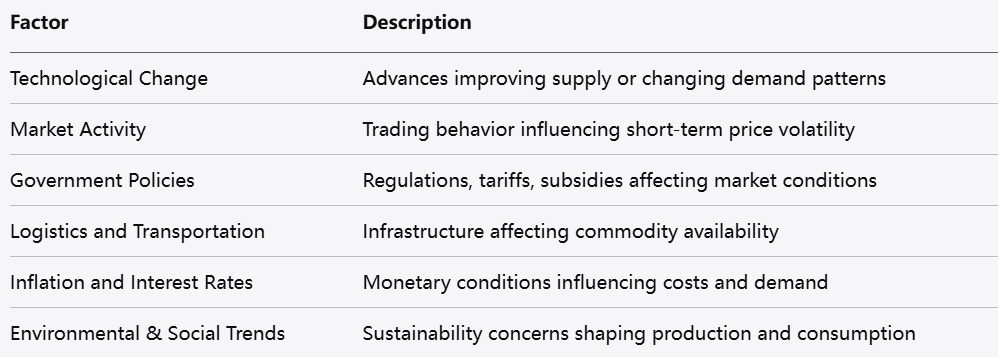
Commodity trading basics: Commodity trading is an essential part of the global financial markets, involving the buying and selling of raw materials like metals, energy resources, and agricultural products.
Commodity market analysis: Understanding what drives commodity prices is crucial for anyone interested in this area, whether for trading, business decisions, or economic study. Commodity prices rarely move in isolation; instead, they respond to a complex mix of forces. This article explores the key factors that influence commodity prices, providing a comprehensive overview for those new to commodity trading.
At the heart of commodity pricing lies the fundamental economic principle of supply and demand. The balance—or imbalance—between how much of a commodity is available and how much is desired plays a pivotal role.
Supply Factors
Supply can be influenced by various elements, including production levels, mining output, agricultural yields, and inventory stocks. Weather conditions, geopolitical events, labor strikes, and technological changes in extraction or farming methods can all affect supply availability.
For example, a drought can reduce crop production, lowering supply and potentially pushing prices upward. Conversely, technological improvements might increase extraction efficiency, boosting supply and exerting downward pressure on prices.

Demand Factors
Demand is shaped by consumption needs across industries, population growth, and shifts in consumer preferences. Economic growth typically increases demand for commodities as manufacturing, construction, and transportation sectors expand.
Changes in industrial activity or shifts toward alternative materials can also alter demand levels. For instance, increased adoption of renewable energy sources may reduce demand for certain fossil fuels, impacting their prices.
The state of the global economy has a broad influence on commodity prices. Periods of expansion tend to boost demand for raw materials, while economic slowdowns can lead to reduced consumption and price declines.
Economic indicators such as manufacturing output, trade volumes, and business sentiment provide insights into demand trends. Moreover, fluctuations in global economic growth rates among key countries or regions can cause shifts in commodity markets.
Currency Movements
Commodities are generally priced in a dominant global currency. Therefore, changes in the strength or weakness of that currency affect commodity prices.

When this currency strengthens, commodities priced in it often become more expensive for buyers using other currencies, which can reduce demand and push prices down. Conversely, a weaker currency can make commodities cheaper internationally, potentially increasing demand and leading to higher prices.
Currency fluctuations can be influenced by interest rate policies, inflation trends, geopolitical events, and market sentiment, thereby indirectly impacting commodity markets.
Political factors can cause volatility in commodity prices. Events such as conflicts, trade disputes, sanctions, and regulatory changes in key producing or consuming countries can disrupt supply chains or alter demand patterns.
Regions rich in natural resources but experiencing instability may see production interruptions, export restrictions, or logistical challenges, tightening supply and affecting prices. Similarly, trade policies or tariffs can shift demand flows and influence pricing.
Because commodities often rely on global supply chains, political developments in one region can ripple throughout markets worldwide.

Seasonality plays an important role, especially for agricultural commodities. Planting and harvesting seasons, weather cycles, and natural disasters can affect crop yields and livestock production.
Unfavorable weather such as droughts, floods, or storms can reduce supply, while favorable conditions may enhance output. Seasonal demand changes, such as increased energy consumption during winter months, also impact prices.
Weather-related factors tend to introduce volatility and uncertainty into commodity markets, requiring close monitoring.
Technological progress can alter both supply and demand dynamics. Improvements in extraction, farming techniques, and processing can increase supply by making production more efficient or enabling access to new reserves.
On the demand side, innovations that substitute traditional commodities with alternatives—like electric vehicles reducing oil consumption—can reshape market patterns.
As technologies evolve, they can create shifts in commodity markets that influence price trends over the medium to long term.
Commodity inventories serve as buffers between supply and demand. Changes in stock levels held by producers, consumers, or strategic reserves influence market balance.
High inventory levels generally indicate ample supply relative to demand, which can put downward pressure on prices. Conversely, low inventories suggest tighter supply, often leading to upward price movements.
Tracking inventory data can provide insights into market conditions and potential price shifts.
While fundamental factors drive the underlying supply and demand, market participants’ trading behavior also affects commodity prices. Speculative trading, hedging by producers and consumers, and portfolio flows can cause short-term price fluctuations.
Large trading volumes, leveraged positions, and shifts in market sentiment may amplify price movements beyond what fundamentals alone would suggest.
Understanding the role of trading activity helps explain volatility and rapid price changes seen in commodity markets.

Government interventions influence commodity markets through policies related to production quotas, export restrictions, subsidies, environmental regulations, and taxation.
For instance, limits on mining output or agricultural subsidies can alter supply. Environmental policies targeting emissions may affect demand for fossil fuels or encourage alternatives.
Regulatory changes often create uncertainty, impacting market expectations and price behavior.
Transportation and Logistics
The ability to move commodities from producers to consumers efficiently is crucial. Disruptions in transportation—due to strikes, natural disasters, or infrastructure issues—can constrain supply chains and affect prices.
Costs associated with shipping and storage also influence commodity prices. Higher logistics costs may be passed on to buyers, contributing to price increases.
Reliable transport and storage infrastructure help maintain market stability, while interruptions introduce risk and volatility.
General inflation trends can influence commodity prices due to their role as physical assets often viewed as stores of value. Rising inflation may increase demand for commodities as a hedge against currency depreciation.
Interest rate levels affect the cost of holding inventories and financing commodity-related activities. Higher rates can increase carrying costs, potentially reducing demand for physical stockpiling and impacting prices.
Monetary policy decisions and inflation expectations thus indirectly play a role in commodity price movements.
Increasing attention to environmental sustainability and social responsibility impacts commodity markets. Demand for ethically sourced or environmentally friendly materials can shift consumption patterns.
Regulations targeting pollution, carbon emissions, and resource conservation influence production methods and costs. Consumer preferences in favor of sustainable products can affect demand for certain commodities.
These factors are becoming more prominent drivers in shaping long-term commodity trends.

Commodity prices are shaped by a complex mix of factors, including supply and demand dynamics, global economic conditions, currency fluctuations, geopolitical events, seasonal and weather effects, technological changes, market trading behaviors, government policies, logistics, monetary influences like inflation and interest rates, and evolving environmental and social trends. Grasping these interconnected influences is key to understanding and navigating the complexities of commodity markets.
Risk Warning: this article represents only the author’s views and is for reference only. It does not constitute investment advice or financial guidance, nor does it represent the stance of the Markets.com platform.When considering shares, indices, forex (foreign exchange) and commodities for trading and price predictions, remember that trading CFDs involves a significant degree of risk and could result in capital loss.Past performance is not indicative of any future results. This information is provided for informative purposes only and should not be construed to be investment advice. Trading cryptocurrency CFDs and spread bets is restricted for all UK retail clients.